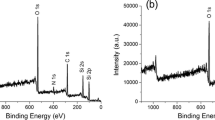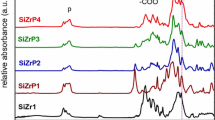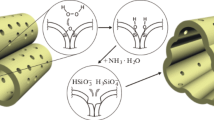Abstract
The generation of porous metal oxides by removal of template molecules from inorganic polymers formed by sol-gel type hydrolysis and condensation of metal alkoxides is described. The template molecules include organic polymers, copper (II) ions in hybrid copper oxide/silica sols and copper (II) bis(hexafluorocetylacetonate) (hfac). Neutron scattering experiments on the system in which polyacrylic acid (Mw=2,000 Daltons) is used as an organic template to generate microporous tin oxide show that removal of the template generates skeletal voids. In a second series of experiments, mixed copper/silicon oxide xerogels were prepared by hydrolysis of mixtures of Si(OEt)4 and Cu(OCH2CH(CH3)N(CH3)H)2 in the ratios of Si:Cu=2:1, 4:1, 9:1. Selective removal (etching) of the copper component generates porous silica. Neutron scattering data and BET surface area measurements are consistent with the creation of pores with molecular dimensions (micropores, 10 Å or less). In the third strategy, Si(OEt)4 is hydrolyzed in the presence of Cu(hfac)2, a volatile, inert inorganic template, in a 4 to 1 molar ratio. Removal of the template from the xerogel at 100°C in vacuo affords microporous silica.
Similar content being viewed by others
References
Klein, L.C., Sol-Gel Technology for Thin Films, Fibers, Preforms, Electronics and Specialty Shapes (Noyes publications, Park Ridge, 1988).
Brinker, C.J. and Scherer, G.W., Sol-Gel Science: The Physics and Chemistry of Sol-Gel Processing (Academic Press, Boston, 1990).
Roger, C. and Hampden-Smith, M.J., ChemTech in press (1993).
Chandler, C.D., Roger, C., and Hampden-Smith, M.J., Chem. Rev. 93, 1205 (1993).
Roger, C. and Hampden-Smith, M.J., J. Mater. Chem. 2, 1111 (1992).
Breitscheidel, B., Zieder, J., and Schubert, U., Chem. Mater. 3, 559 (1991).
Popall, M., Meyer, H., Schmidt, H., and Schulz, J., Mater. Res. Soc. Symp. Proc. 180, 995 (1990).
Jacobs, P.A. and Martens, J., Synthesis of High Silica Zeolites (Elsevier, Amsterdam, 1987).
Roger, C., Hampden-Smith, M.J., and Brinker, C.J., Mater. Res. Soc. Symp. Proc. 271, 51 (1992).
Rousseau, F., Jain, A., Kodas, T.T., Hampden-Smith, M.J., Farr, J.D., and Muenchausen, R., Chem. Mater. 2, 893 (1992).
Goel, S.C., Kramer, K.S., Gibbons, P.C., and Buhro, W.E., Inorg. Chem. 28, 3620 (1989).
Author information
Authors and Affiliations
Rights and permissions
About this article
Cite this article
Roger, C., Hampden-Smith, M.J., Schaefer, D.W. et al. General routes to porous metal oxides via inorganic and organic templates. J Sol-Gel Sci Technol 2, 67–72 (1994). https://doi.org/10.1007/BF00486215
Issue Date:
DOI: https://doi.org/10.1007/BF00486215




